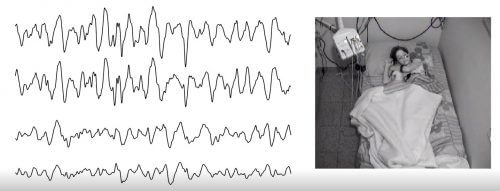At least half of children with autism suffer from insomnia. A study conducted at the National Autism Research Center at Ben-Gurion University measured the brain activity of these children during their sleep for the first time and revealed that they do not develop deep sleep patterns. The findings pave the way for finding solutions to the problem that bothers the children and their families

Sleep disorders are one of the most common and disturbing symptoms among children with autism, but the cause of these disorders is unknown. A new study conducted at the National Autism Research Center at Ben-Gurion University measured for the first time the sleep waves in the brains of children with autism throughout the night. In children with autism it was found that the intensity of the waves is, on average, about 25% lower than the intensity in children without autism. The results of the study show that, unlike the control children, children with autism develop weak sleep waves that characterize shallow and superficial sleep, similar to the sleep of people who are not tired. The researchers believe that in doing so they have identified the mechanism behind at least some of the common sleep problems in children with autism. The study was published in the world's leading scientific journal on sleep - Sleep.
Many studies around the world have shown that approximately 40-80% of children on the autism spectrum suffer from insomnia. These children have difficulty falling asleep, wake up often during the night, and wake up early in the morning so that their total sleep hours are about half of what is expected of their peers. Many parents testify that the difficulty in falling asleep and the fragmented sleep create an extremely difficult struggle for the child and his family members and cause damage to the quality of life, irritability, irritability, aggression, and more.
For this reason, the research team led by Prof. Ilan Dinstein from the Department of Psychology and head of the National Center for Autism Research decided to investigate the issue. During the study, the brain activity of 29 children with autism and 23 children without autism was recorded for the first time. The children arrived at the sleep laboratory at the Soroka Medical Center under the direction of Prof. Ariel Tersiuk and their brain activity was recorded using an EEG system during an entire night. The analysis of the findings shows that the sleep of the children with autism was shallow and superficial compared to the control children and looked like that of children who are not tired. This difference was particularly large at the beginning of the night and was especially noticeable in children with more severe sleep problems.
The brain waves that indicate deep sleep are slow waves with frequencies of 1-4 Hz. The greater the power of the brain waves at these frequencies, the deeper the sleep. In children with autism it was found that the intensity of the waves is, on average, about 25% lower than the intensity in children without autism. This difference was especially noticeable in the first hours of the night, when sleep is the deepest, and gradually disappeared later in the night, during the hours when sleep naturally becomes shallower in everyone. (See attached graph).
"It seems that the children with autism, and especially those whose parents reported that they have severe sleep problems, do not get tired enough during the day, do not develop pressure to sleep, and their brains do not enter deep sleep activity when they fall asleep," says Prof. Dinstein, "the findings indicate that the brains of The children with autism do not develop deep sleep patterns that are essential for resting the brain and creating the feeling of freshness that comes after deep sleep. Moreover, a relationship was found between the severity of the sleep problems as reported by the parents and the depth of the sleep, so that children with more severe problems showed brain activity indicating shallower and more superficial sleep."
As a continuation of this work, the researchers plan to conduct several follow-up studies to test interventions that can enhance the depth of sleep in the relevant children. These studies will test simple interventions such as increasing physical activity during the day to testing behavioral intervention and the use of food supplements such as melatonin and drugs such as medical cannabis.
The study was supported by the Simmons Foundation for Autism Research.
More of the topic in Hayadan:

3 תגובות
My son is autistic and I wish I was a sound sleeper like him. I don't think that a study of only 23 subjects is statistically representative enough to draw conclusions about autistic people
I wonder what the findings are for children with ADHD?
"See attached graph"
I saw the graph, but it doesn't say what each wave means
A comparison between an autistic child and a normal one?
Comparison between sleeping at the beginning of the night and the end?